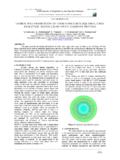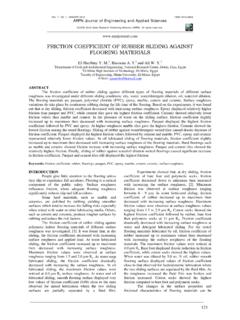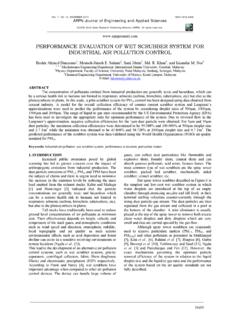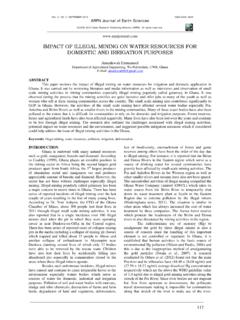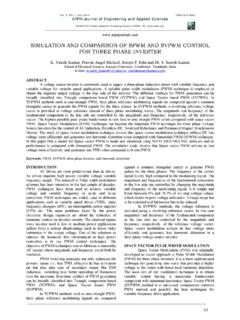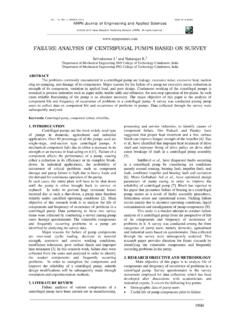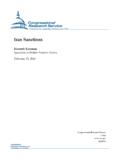Transcription of AQUIFER SIZE DETERMINATION FROM MATERIAL …
1 VOL. 9, NO. 9, SEPTEMBER 2014 ISSN 1819-6608 ARPN Journal of Engineering and Applied Sciences 2006- 2014 Asian Research Publishing Network (ARPN). All rights reserved. 1540 AQUIFER SIZE DETERMINATION FROM MATERIAL BALANCE FOR GAS RESERVOIRS Freddy Humberto Escobar, Jorge-Andr s Tovar and Victor-Alfonso Andrade Universidad Surcolombiana/CENIGAA, Avenida Pastrana - Cra 1, Neiva, Huila, Colombia E-Mail: ABSTRACT During decades, reservoir engineers have used the MATERIAL balance equation, MBE, for estimating reserves, gas cap size and amount of water influx of oil and gas reservoirs.
2 It has also been used as a tool for prediction the behavior and ultimate recovery of a given hydrocarbon reservoir and, since then, many modifications have been introduced to the MBE. In this work, a reservoir simulation study is conducted for a non-volumetric gas reservoir with different AQUIFER sizes so a correlation was developed for estimating the size of an underlying AQUIFER from MATERIAL balance. The developed expression was successfully tested with field and simulated examples. Keywords: AQUIFER size, non-volumetric gas reservoir, bottom-water drive. 1. INTRODUCTION MATERIAL balance is maybe the most used tool by reservoir engineers during several decades. Its main applications lead to the estimation of hydrocarbon in place, water influx and gas cap size.
3 The general MATERIAL balance equation was first introduced by Schilthuis (1936). Since then, thousands of papers have been published on either field applications or further developments. With the continuous growing in computer power and mathematical development, the zero dimensional Schilthuis MBE has been replaced for multidimensional mathematical models for simulation a variety of fluid flow situations as indicated by Cheng, Huan, and Ma. G. (2006), among several. However, the Schilthuis MBE, if fully understood and properly used, can provide significant results for the practicing reservoir engineers. Among a great amount of publications on MATERIAL balance, a method of linearization of the MBE was introduced by Havlena and odeh (1963, 1964) with resulted in a much more practical application of Schilthuis MBE.
4 The plot of p/Z versus cumulative gas production is a widely accepted method for solving gas MATERIAL balance under depletion drive conditions. The extrapolation of the plot to atmospheric pressure provides a reliable estimate of the original gas-in-place. If a water drive is present the plot often appears to be linear, but the extrapolation will give an erroneously high value for gas-in-place. The extrapolation of the plot to atmospheric pressure provides a reliable estimate of the original gas-in-place. If a water drive is present the plot often appears to be linear, but the extrapolation will give an erroneously high value for gas-in-place. However, a few years ago, Elahmadi and Wattenberger (2007) recently presented an application of the p/Z plot in water drive gas reservoirs.
5 The Cole Plot, Cole (1969), is a useful tool for distinguishing between water drive and depletion drive gas reservoirs. The plot is derived from the general MATERIAL balance equation for gas reservoirs. For oil reservoirs, the Campbell Plot is the counterpart to the Modified Cole Plot for gas reservoirs. The Roach Plot, Poston and Berg (1997), has been presented as a tool for solving the gas MATERIAL balance in the presence of water drive. Pletcher (200) shows that for water drives that fit the Pot AQUIFER model, interpretation can be improved by including water production in the X-axis plotting term. This improves the linearity of the plot and gives more accurate values for OGIP.
6 Water reservoirs in contact with hydrocarbon reservoirs may be very large or so small that his effect can be neglected. AQUIFER activity may be evidenced by water production or low pressure depletion caused by AQUIFER reaction. However, a few times the AQUIFER size is known. Since high gas saturation may be trapped from water influx from aquifers, gas recovery factor from no-volumetric reservoirs may be poor (50-70% of OGIP). These recovery factors can be increased by improving the well production. It can also be achieved if the properties of both gas reservoir and AQUIFER are known. Among them, AQUIFER size plays an important role in water influx. If the AQUIFER /gas reservoir radii relationship is greater than 10 the AQUIFER is considered to be infinite and its water providing capability is higher than finite AQUIFER size.
7 Targac, Wattenbarger and Startzman (1990) developed two AIF ( AQUIFER -Influence Function) type curves for aquifers. They were applied to 32 American gas reservoirs; An AIF can be obtained from the production-pressure register of a gas reservoir. The AIF is unique for a given AQUIFER and, among other applications, can be used for estimation of the AQUIFER size. The AQUIFER size can be estimated using the slope, m, of a Cartesian plot of AIF vs. Time (months) by using the following expression: 1ptVmc= (1) The calculated pore volume corresponds to the pore volume of the AQUIFER underlying the gas reservoir. The calculation applies to any AQUIFER geometry only if this acts under pseudosteady state.
8 For infinite AQUIFER sizes, the AQUIFER size can be estimated using the late-time slope of the AIF. VOL. 9, NO. 9, SEPTEMBER 2014 ISSN 1819-6608 ARPN Journal of Engineering and Applied Sciences 2006- 2014 Asian Research Publishing Network (ARPN). All rights reserved. 1541In this work, the estimation of the AQUIFER size is achieved from a Cartesian plot of (GpBg+WpBw)/ (Bg-Bgi) vs. [G+We/ (Bg-Bgi)]. The slope of such plot changes as the AQUIFER s size changes; then, numerical simulation was used to generate cases for several AQUIFER sizes then a correlation was established.
9 It was successfully applied to synthetic and field cases. Only the field case is reported. AquiferGas reservoir Figure-1. Reservoir model with ra/re=2. 2. SIMULATION SET UP The study model consists of a conventional dry gas reservoir drained by a unique producer well located in the center of the reservoir. As depicted in Figure-1, there also exists an underlying AQUIFER is influencing the gas reservoir. A commercial simulator was used to evaluate the gas reservoir behavior under several aquifers sizes. In this research the gas reservoir volume was kept constant while the AQUIFER /gas reservoir radii relationship was set to variations ranging from ra/re=1, to ra/re=10, keeping in mind that relationships higher to 10 corresponds to infinite AQUIFER size.
10 Since such parameters as permeability have a wide impact in the water influx behavior, Armenta (2003), three different cases were conducted using different permeability values. Besides, the gas flow rate has certain effect on the amount of water influx from the AQUIFER ; then, gas flow rate variations were also consider in the analysis. The three study cases are reported in Table-1. Table-1. Permeability and gas flow rate values considered in the study. Case qg, Mscf/Day k, md 1 300 100 2 400 100 3 400 500 Table-2 and 3 and Figure-2 present the fluid and petrophysical poperties used in the simulation runs.

